

Developing Motives (or How To Write a Symphony With Only Four Notes) Many beginning composers are under the impression that the great masterpieces of music came spilling out of the composer's mind in a flash of genius, complete and perfect in their entirety.
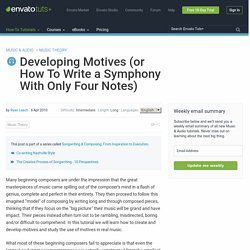
They then proceed to follow this imagined "model" of composing by writing long and through composed pieces, thinking that if they focus on the "big picture" their music will be grand and have impact. Their pieces instead often turn out to be rambling, misdirected, boring and/or difficult to comprehend. In this tutorial we will learn how to create and develop motives and study the use of motives in real music. What most of these beginning composers fail to appreciate is that even the longest and most epic masterpieces are actually constructed from the smallest and simplest of elements: the motive. By using the motive as the essential architectural element of your composition you can create the perfect balance of comprehension and variety. The most famous motive in all of Western music is this one:
Classical Music Today - Composition Exercises. These exercises are meant for musicians who wish to explore the world of classical composition.

They may be completed in any order. I will periodically add composition exercises to this page. Feel free to share these with your fellow classmates and students. I completed many of these exercises during my studies. I hope that you find them both challenging and useful.Exercise 1: Compose Three Short One Minute Compositions In this exercise, you must complete three short compositions in no more than two weeks. How to make a Reverse Glass Effect. Some sounds are ubiquitous standbys, familiar friends that even define and carry the name of a music genre.
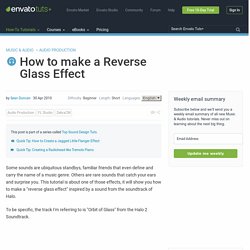
Others are rare sounds that catch your ears and surprise you. Some sampling do’s and don’t for beat makers. This title may be misleading.

The point of this is not to tell you what samples might get you sued or what has already been used on previously released song.. No, this is a bit different. The Ultimate Equalizer (EQ) Guide. The equalizer is one of the most useful tools available to any recording engineer.
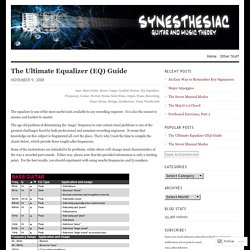
It is also the easiest to misuse and hardest to master. The age old problem of determining the ‘magic’ frequency to cure certain tonal problems is one of the greatest challenges faced by both professional and armature recording engineers. It seems that knowledge on this subject is fragmented all over the place. Phat Drums Loops: Free Funky Drum Samples! "Drum Crazy v1, t1" (36k) Michael White's Magic Music Company, "Spaceslide" -- [Sureel] (on the album "Let It Flow" on ABC/Impulse, 1974) "Drum Crazy v1, t2" (19k) Jon Lucien, "Ghetto Song" -- [ Sureel] (on the album "Mind's Eye" on RCA , 1973?)
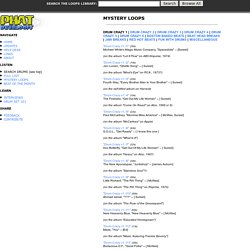
VST-Synth. Producing Rhythm: How to Add Amazing Feel to Your Tracks - Envato Tuts+ Music & Audio Tutorials. Scales and emotions. See also a post about making chords from scales.

So maybe you want to write a song or an instrumental in a particular mood or style, and you’re feeling overwhelmed by all the scales. Here’s a handy guide to the commonly used scales in Western pop, rock, jazz, blues and so on. Click each image to play the scale right in your browser with the aQWERTYon. These scales have a major third (E in the key of C), which makes them feel happy or bright. Major scale Happy; can be majestic or sentimental when slow. 5 Priceless Composition Tips for the Young Composer - Cyberfret.com.
Free Download - 17 Essential Strum Patterns PDF For me, composition is one of the most rewarding events I can partake in.
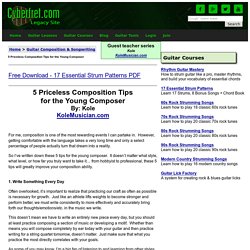
However, getting comfortable with the language takes a very long time and only a select percentage of people actually turn that dream into a reality. So I’ve written down these 5 tips for the young composer. It doesn’t matter what style, what level, or how far you truly want to take it… from hobbyist to professional, these 5 tips will greatly improve your composition ability. 1. Programming Your Own Percussion Beds - Composer Focus. No modern action score is complete without a rousing percussion section hammering away beneath the rest of the instruments.
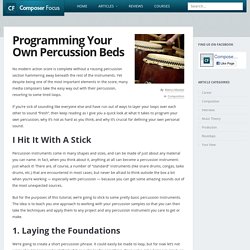
Yet despite being one of the most important elements in the score, many media composers take the easy way out with their percussion, resorting to some tired loops. MusicArrangers.com; Musical Instruments Reference. Songwriting & Composing: From Inspiration to Execution - Envato Tuts+ Music & Audio Tutorials. Using Ambient Techniques For Composing. "In modern recording one of the biggest problems is that you're in a world of endless possibilities.
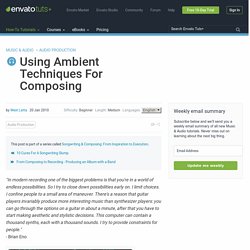
So I try to close down possibilities early on. I limit choices. I confine people to a small area of maneuver. There's a reason that guitar players invariably produce more interesting music than synthesizer players: you can go through the options on a guitar in about a minute, after that you have to start making aesthetic and stylistic decisions. This computer can contain a thousand synths, each with a thousand sounds. I've been thinking a lot lately about limitations and possibilities in relation to composing. Online guitar chords. Composers Do's and Don't's of Music Composition. These are the do's and do not's for music composers. It is not a complete course in music composition. You will not find much music theory here.
All I offer you is some sound advice. Composition Exercise on Melodic Cells – Wilktone. One analogy I like to offer new composers is that writing music is a lot like performing music – it takes a lot of practice to get good at it. Learning to play an instrument well requires practicing exercises that aren’t really meant to be performed, but are designed to help us develop certain skills. Composers sometimes forget that we can do the same – develop our abilities by composing music that isn’t intended to ever be performed.
One way I like to stretch myself as a composer is to pick a particular musical element and sketch out some short compositions that only focus on that one idea. Today I’m going to practice my melodic writing and explain a bit my thought process so that other composers can take the basic idea of this exercise and alter it to fit their own needs and style. The first thing I’m going to do is simply play those pitches in that order slowly and notice the shape and patterns the pitches make. The Ultimate EQ Cheat Sheet for Every Common Instrument. Image via Shutterstock You asked, and you shall receive, Sonicbids blog readers. Per multiple requests, here's my guide to, "When the hell do I start turning these knobs, and where do they go? " But before we begin, I offer you the fine print: These references are general ideas for where to begin to look for sonic issues with particular sounds, instruments, and voices.
I'm not going to tell you "always notch this 9 dB here and add 3 dB here with a wide boost and, voila, perfect sound! " because it's unfortunately just not that simple. ギターコード指板図くん. ギターコード スコアメーカー [ギターコード表] 作曲の仕方、曲を作ってみよう! さて、いよいよ曲作りに挑戦してみるわけですが自分がやっている主な作曲法としては コードを使って作曲するという方法です。 先ほど前のページで覚えたコードを使います。 まずは簡単にCコードとFコードとGコードを使って曲の伴奏を作ってみましょう。
コード進行パターン集. Music school M-Bank コード進行辞典. 音楽理論/作曲/アドリブ/不定調性論のメール基礎通信講座は⇒こちらからオリジナル講座/不定調性進行実例に関するブログは⇒こちらから I系開始曲(No.1~No.30) I系開始曲(No.31~No.60) II系開始曲(作成中) III系以降開始曲(作成中) コード進行で音楽を理解できるわけではありませんが、音楽のキャンバスとなるコード進行の無数のバリエーションが作曲のインスピレーションを与えるときがあります。 ここではM-Bankの書庫にある譜面の山から、どこでも、いつでも、セッションでも、作曲にも使用できるようなコード進行を列挙してみました(順次増曲中!)。 Music school M-Bank コード進行辞典. Music Theory: Exotic Scales<meta name="description" content="A scale is merely a series of tones that lie between octaves. That's not too much different than the definition of a chord."> <meta name="keywords" content="exotic scales major scales minor scal. A scale is merely a series of tones that lie between octaves. That's not too much different than the definition of a chord. The main difference, however, is that a scale represents the foundation of a piece of music.
Tips for Creatively Processing Drum Loops. ➥ The new e-book from Cristofer Odqvist is available now In most modern music production, be it Pop, Hip-Hop or Electronic music, we may be dealing with a lot of drum loops or music loops that are (at best) just a stereo file. A lot of times we might want to change certain elements of the loop, either to fit the production better, achieve some variation over time, or simply put our own spin on the sample or loop at hand. Random Beat Generator. 23 Compression tips ~ FL STUDIO EQ AND COMPRESSOR. The basics Compression basically explained: the reason people ask about compression more than anything is because they find it the hardest concept to understand or hear. A basic explanation I heard when I first started was thinking of compression like an automatic volume control, when the audio is loud it gets turned down and when it's soft it gets turned up.
This means sharp signals are now curved and fading signals are now picked up and last longer. It also means smoother sounds and fatter notes. Soft knee, hard knee Unless you have a software compressor or a really high-end model, you won't be able to choose the setting. Controlling Gross Beat. FL Studio Guru - Edison Harmonic Filtering. Creating 'Blur Pads' Online Random rhythm Motif Generator. Some ways you can use these rhythm patterns. 1) You can play around with these patterns by going to the online drum sequencer and enter the pattern into the app to sample the pattern. 2) Combine both patterns to make a new single pattern. 3) Augment the Values. Tones: Generate a Composition. EQ: How & When To Use It. Tips & Techniques. The List 2 - The Best Free Synths. Sound Synthesis – Understanding the Basics. Many of those who use synthesizers in the modern technological world are not well versed in the basics of different kinds of synthesis.
With the ease of computer-based synthesis, any synthesis program can be opened and fiddled around with by ear until something “cool” comes out. To break the mold in the use of synthesizers in the modern music world, you have to be educated or lucky. Using EQ when mixing - analysis of each EQ band. Free Jazz Funk Drum Sample Library. Big Mono (for Kontakt, EXS24, Wav) by Analogue Drums. Music Composition 5: Odd Meters — Secret Composer. 3.5 Gb Of Hq Ochestral Sf2! HQ Orchestral Soundfont Collection >>>v3.0<<< UPDATED 5/3/14 >>>DRUMSETS NOW INCLUDED<<< Links to SoundFonts. The Ultimate Guide to Drum Programming - EDMProd. Studio Production Tips - 10 Ways To Improve Your Production.
10 Essential Mixing Tips for FL Studio Users. MIDI Software. Yamaha DX7: Dexed Plugin + 3000 soundbanks - The Music Producer Blog. Jazz chord. Classical Music Today - Composition Exercises. How to Compose Music 101. How To Use Layering To Make Your Leads Sound Huge. The Joy Of Sidechaining. ModeAudio Magazine. Creative Chord Progressions. Jazztruth: Write Something(Composition Exercises I ) What scales and chords used in funk? FREE FUNKY KEYS!!!: Links. SoundFont Downloads. Bigcat Instruments. ElectriKeys Electric Piano VST Plugin (Fender Rhodes, Wurlitzer, Hohner Clavinet D6, Yamaha CP70) Funky Clavinet. Free Yamaha DX21 Fuzz Clavinet samples. FREE SYNTH SAMPLES - EXS24 - KONTAKT - REASON - LIVE. Emotions of the Musical Keys. Characteristics of Musical Keys. Freesound.org - Sound by b.one. Hooktheory - Music theory, songwriting software, and popular song analyses. Quick Tip: Bringing More Power To Your Drum Samples in FL Studio - Tuts+ Music & Audio Tutorial.
How To Use Parallel Processing In FL Studio. How to Build Tracks So That Instruments Relate to Each Other - Tuts+ Music & Audio Tutorial. How to Layer Sequences to Create Depth and Pace - Tuts+ Music & Audio Tutorial. Harmor. Creating Layered Instruments in FL Studio. Harmonizer VST 7aliens. Native Instruments FM7. Afro-Latin Percussion Vol.2 - Another exciting collection of acoustic percussion loops. Rhythms of Arabia - Classic rhythms of Arabia. Untitled. AngryOctopus. Music theory at LearnMusicTheory.net. Preview: LinnStrument. Wav Samples. Music Generators. Free VST.